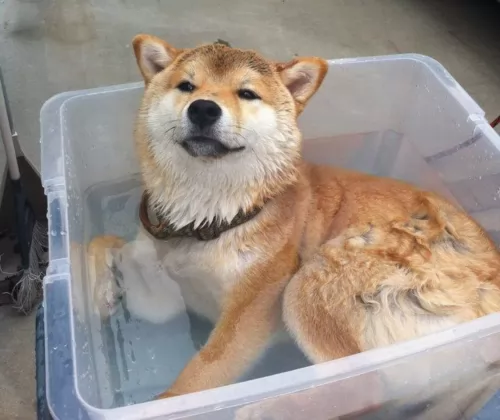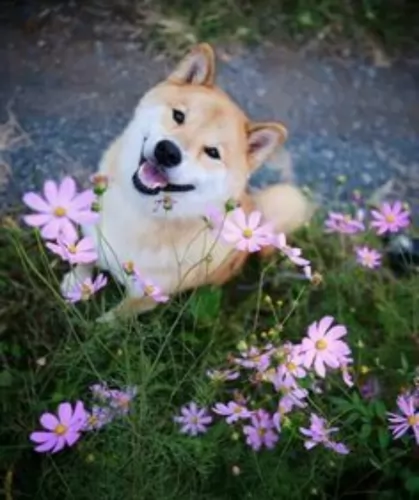 MyDogBreeds
MyDogBreeds Shiba Inu is originated from Japan but Chesapeake Bay Retriever is originated from United States. Shiba Inu may grow 23 cm / 9 inches shorter than Chesapeake Bay Retriever. Shiba Inu may weigh 34 kg / 74 pounds lesser than Chesapeake Bay Retriever. Both Shiba Inu and Chesapeake Bay Retriever has almost same life span. Shiba Inu may have less litter size than Chesapeake Bay Retriever. Both Shiba Inu and Chesapeake Bay Retriever requires Low maintenance.
Shiba Inu is originated from Japan but Chesapeake Bay Retriever is originated from United States. Shiba Inu may grow 23 cm / 9 inches shorter than Chesapeake Bay Retriever. Shiba Inu may weigh 34 kg / 74 pounds lesser than Chesapeake Bay Retriever. Both Shiba Inu and Chesapeake Bay Retriever has almost same life span. Shiba Inu may have less litter size than Chesapeake Bay Retriever. Both Shiba Inu and Chesapeake Bay Retriever requires Low maintenance.
 The Shiba Inu hails from Japan and was a dog bred to hunt birds and small game. The dog is one of 6 native breeds in Japan. Today he is essentially a companion dog in both Japan and the United States.
The Shiba Inu hails from Japan and was a dog bred to hunt birds and small game. The dog is one of 6 native breeds in Japan. Today he is essentially a companion dog in both Japan and the United States.
He is actually one of the smaller spitz dogs in the country but known for his boldness.
The first Shiba Inu was imported into the United States in 1954 and was recognized by their Kennel Club in the Miscellaneous Class and also the Non-Sporting Group.
 Fondly referred to as the Chessie, the ‘Labrador-look-alike’ Chesapeake Bay Retriever’s history extends to St. Johns Newfoundland pups which were rescued off a ship off the coast of Maryland in 1807. The Chesapeake is an American breed.
Fondly referred to as the Chessie, the ‘Labrador-look-alike’ Chesapeake Bay Retriever’s history extends to St. Johns Newfoundland pups which were rescued off a ship off the coast of Maryland in 1807. The Chesapeake is an American breed.
It is believed that the Newfoundland puppies as they grew, were bred with area dogs, with there being few records of the early dogs, but it is believed that spaniels and dogs were included.
In 1918 the Chesapeake Bay Retriever was recognized by the American Kennel Club and in 1964 the dog was declared the official dog of Maryland.
 The Shiba Inu is a medium sized, athletic dog standing at between 33cm and 43cm in height both male and female and weighing in the region of 6 to 11kg.
The Shiba Inu is a medium sized, athletic dog standing at between 33cm and 43cm in height both male and female and weighing in the region of 6 to 11kg.
He is an agile dog, known for his feline agility. He has the typical spitz dog erect ears and slanted eyes with the tail curling over the back.
The coat is available in a number of colors – cream, red, sesame, black and tan.The double coat is thick and is made up of straight, stiff kind of hair.
This is an intelligent, independent, alert, strong willed dog who has a calm aura about him. He is stubborn too, so it will be best to have him trained or socialized just to make him more amicable to get along with.
As he is a dog that just loves his human family, this training helps him to get along with other dogs too. He is possessive with his human family, wanting to guard them and everything he regards as his territory.
 The Chesapeake is a large dog belonging to the Sporting breed group. Perhaps one of the more distinctive features of the Chesapeake Bay Retriever is the yellowish eyes.
The Chesapeake is a large dog belonging to the Sporting breed group. Perhaps one of the more distinctive features of the Chesapeake Bay Retriever is the yellowish eyes.
This is a strong, well muscled dog that stands anywhere from 61 – 66cm and weighs between 30 – 45kg. The short, thick coat of the dog is waterproof and comes in colors ranging from brown to reddish yellow to chestnut shades.
The head of the Chesapeake is broad and roundish with medium length floppy ears. The tail is long. The toes are webbed which helps makes the dog an excellent swimmer as well.
The Chesapeake Bay Retriever is a happy kind of dog with a bright, alert, intelligent expression. He loves water and is guaranteed to make a wonderful pet for any family.
With his wonderful characteristics, it is worth training him and socializing him as this training sets parameters for him so that he becomes a wonderfully obedient dog that gets on well with other pets in the home as well as with children.
 He is the smallest of several spitz dogs that originated in Japan. He is known for his bold, feisty personality and for being so good natured as well. Other excellent characteristics are intelligence, strong-willed, loyal and loving and he has a calm, confident dignity around him.
He is the smallest of several spitz dogs that originated in Japan. He is known for his bold, feisty personality and for being so good natured as well. Other excellent characteristics are intelligence, strong-willed, loyal and loving and he has a calm, confident dignity around him.
He will get on well with kids and other dogs he has grown up with but he can be a bit aggressive towards dogs he doesn’t know.
Always ensure good exercise. Getting outside and active is important for this dog.
You can certainly benefit from having this wonderful dog in your life as he has some excellent characteristics.
 The Chesapeake Bay Retriever is ready to be your best friend and companion. This dog breed is highly active and he’ll fit easily into a family that is active and can ensure he is involved in all their activities.
The Chesapeake Bay Retriever is ready to be your best friend and companion. This dog breed is highly active and he’ll fit easily into a family that is active and can ensure he is involved in all their activities.
The beauty about the Chesapeake Bay Retriever is that he is generally an even tempered dog, and once trained and socialized, becomes a truly splendid pet, one that will be loving and loyal with his owners.
 Shiba Inus are generally healthy, but like all breeds, they're prone to certain health conditions. Look out for things such as hip dysplasia, hypothyroidism, bloat, cancer, eye diseases and skin allergies.
Shiba Inus are generally healthy, but like all breeds, they're prone to certain health conditions. Look out for things such as hip dysplasia, hypothyroidism, bloat, cancer, eye diseases and skin allergies.
Skin allergies can come about because of being allergic to food, fleas, too much shampooing and some medications. It can be traumatic for your pet who will sometimes chew and bite to get relief. Treatment varies but get your pet to the vet.
There is pressure in the eye, and symptoms can include vision loss and pain. Glaucoma can be treated with eye drops but sometimes surgery is required.
 By taking good care of your Chesapeake, you can ensure his teeth remain strong, his nose is wet and his coat glossy and healthy. He is a robust breed as it is, but there are always some common dog diseases to watch out for -
By taking good care of your Chesapeake, you can ensure his teeth remain strong, his nose is wet and his coat glossy and healthy. He is a robust breed as it is, but there are always some common dog diseases to watch out for -
Obesity is an ailment that is afflicting many humans and their pets. Being overweight can bring on a host of unwanted diseases. Obesity is a serious disease that can contribute to digestive disorders, back pain, heart disease and joint problems.
Instead of showering him with little treats to show him how much you love him, rather stroke him or play a game with him – it’s the ultimate treat for him – your attention.
Remember that if you aren’t going to let your Chessie become a parent, the best thing you can do for your male or female is to have them spayed or neutered. In fact, spaying or neutering can decrease the likelihood of your pet getting certain types of cancers as well as other illnesses. Speak to your vet and discover how these procedures can be very beneficial for your pet.
 A nice long walk out and about in the neighborhood is good for this dog. Apart from a daily workout, he will love to come running with you or if you go cycling, he will run next to you. He will require exercise every day.
A nice long walk out and about in the neighborhood is good for this dog. Apart from a daily workout, he will love to come running with you or if you go cycling, he will run next to you. He will require exercise every day.
Brushing your Shiba Inu will be required at least twice a week as he is a dog that sheds quite a bit throughout the year. You want to get rid of those loose hairs to keep him looking nice and groomed.
Never pop sugary treats into your pets mouth and avoid feeding him spicy, toxic foods. It can drastically upset his digestion.
You can feed your Shiba Inu commercially manufactured food but it should be the best quality ones. Give him some tasty homemade food too. Simply add into one big pot chicken, brown rice or pasta and spinach, sweet potatoes and carrots. This food can all be chopped up, refrigerated and added warmed up and in small portions to your pets dry kibble once or twice a week.
Try and also give him some raw meat occasionally. Ensure that there is always a bowl of fresh, cool water within his reach.
 The Chesapeake Bay Retriever sheds fairly heavily throughout the year. The coat should be brushed at least twice a week to remove dead hair. Brushing is good for the dog too as it distributes the oils of the skin, making his coat shinier.
The Chesapeake Bay Retriever sheds fairly heavily throughout the year. The coat should be brushed at least twice a week to remove dead hair. Brushing is good for the dog too as it distributes the oils of the skin, making his coat shinier.
Because the Chesapeake has floppy ears, the ears will need to be checked on a weekly basis for signs of infection. This is of particular importance if your Chessie loves to spend time splashing around in water. The veterinarian can recommend and also advise on cleaners for your dog’s ears.
An excellent diet and plenty of exercise will ensure your Chessie can live to be 11, 12 or 13 years of age. You want to keep his diet of kibble, rice, vegetables and meat consistent so as not to upset his stomach.
Avoid giving him foods such as chocolates. Do research on the harm you can do to your pet when you feed him some human foods that are entirely not meant for a dog’s digestive system.
The Chesapeake Bay Retriever has always loved to be active - hunting for- and retrieving birds from rivers and lakes. He is used to being active and will require a good supply of exercise. Take him for long walks and let him join you on your runs or your cycling.